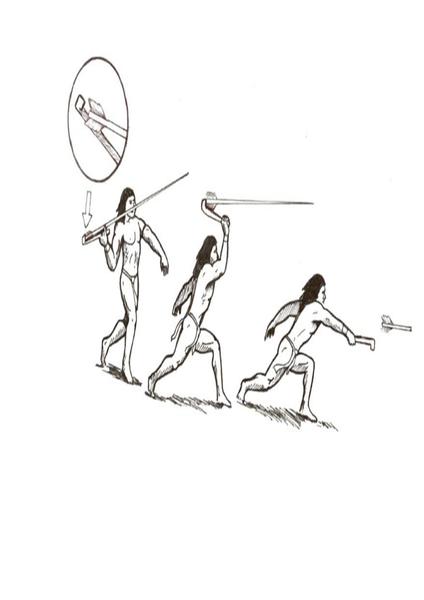Welcome to DU!
The truly grassroots left-of-center political community where regular people, not algorithms, drive the discussions and set the standards.
Join the community:
Create a free account
Support DU (and get rid of ads!):
Become a Star Member
Latest Breaking News
Editorials & Other Articles
General Discussion
The DU Lounge
All Forums
Issue Forums
Culture Forums
Alliance Forums
Region Forums
Support Forums
Help & Search
Anthropology
Related: About this forumSmall-scale atlatl artifacts suggest children were taught how to use them
An image of an atlatl from wikipedia - the text on this page is in Spanish:

From phys.org:

A pair of researchers with the University of Alberta has found evidence that suggests early Native American adults taught children how to use an atlatl by making a smaller version of the dart-throwing device. In their paper published in the journal Antiquity, Robert Losey and Emily Hull describe the artifacts they studied from the Par-Tee burial site in Oregon and what they learned about them.
An atlatl was a device made from wood or whalebone that allowed a human to throw a dart or spear farther and with more accuracy than could be done with the hand alone, though it took much practice to become skilled in its use. The device worked by applying torque as the dart was released from the hand. It was used for both hunting and fighting other people.
Prior research has shown that the atlatl was developed thousands of years ago and used by various groups in Europe and the New World until the bow and arrow was invented. Back in the 1960s, archaeologists discovered an area along the Oregon coast that harbored thousands of artifacts in a place called the Part-Tee shell midden site. Digging unearthed a host of tools and weapons from approximately AD 100–800 —among them, a large number of atlatls.
The researchers report that little study was conducted on the artifacts—they have mostly been sitting in storage. In their effort, they sifted through the trove, focusing on atlatl fragments—most that were found were broken. The researchers found that the grips of the artifacts varied in size—the largest was found to be 166 percent larger than the smallest. And the smallest were too small to have been used by adults, suggesting they had been made for children. The researchers suggest that adults trained the younger members of their group in how to use the valuable tool. They note that skill in using such a tool would serve hunters and fighters well as they grew to adulthood—those most proficient at using an atlatl were likely more successful in hunting and fighting.
InfoView thread info, including edit history
TrashPut this thread in your Trash Can (My DU » Trash Can)
BookmarkAdd this thread to your Bookmarks (My DU » Bookmarks)
3 replies, 1069 views
ShareGet links to this post and/or share on social media
AlertAlert this post for a rule violation
PowersThere are no powers you can use on this post
EditCannot edit other people's posts
ReplyReply to this post
EditCannot edit other people's posts
Rec (7)
ReplyReply to this post
3 replies
 = new reply since forum marked as read
Highlight:
NoneDon't highlight anything
5 newestHighlight 5 most recent replies
= new reply since forum marked as read
Highlight:
NoneDon't highlight anything
5 newestHighlight 5 most recent replies
Small-scale atlatl artifacts suggest children were taught how to use them (Original Post)
Jim__
Dec 2019
OP
When survival was dependent on being able to use weapons for hunting and/or fighting,
Arkansas Granny
Dec 2019
#1
Arkansas Granny
(31,827 posts)1. When survival was dependent on being able to use weapons for hunting and/or fighting,
it isn't much of a stretch of the imagination to believe that training started at an early age.
Nitram
(24,604 posts)2. Fascinating.
wnylib
(24,393 posts)3. Well, uh, yeah. No surprise here. Adult people around the
world and across the ages teach children what they need to know for their society and environment.